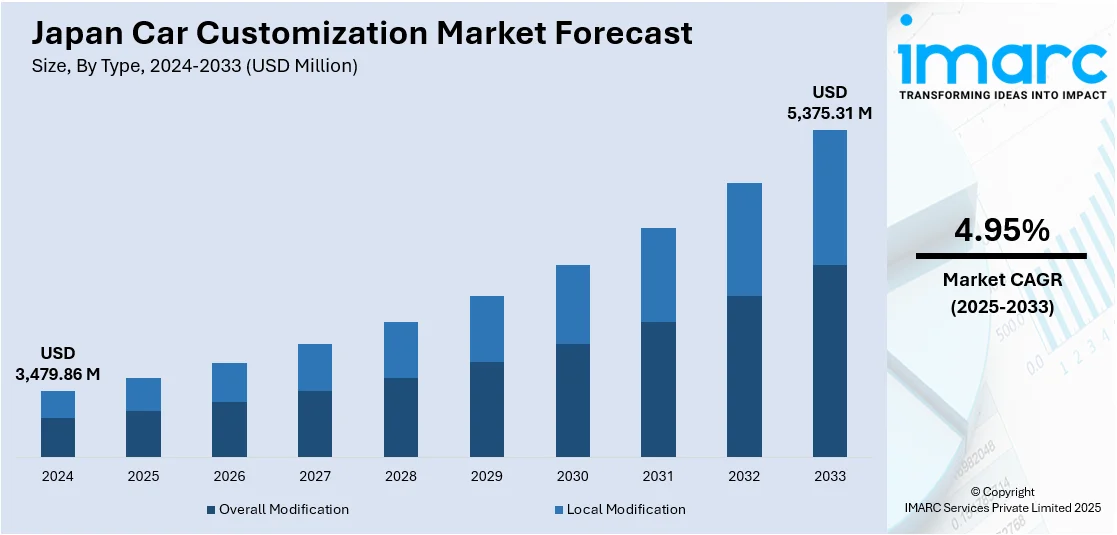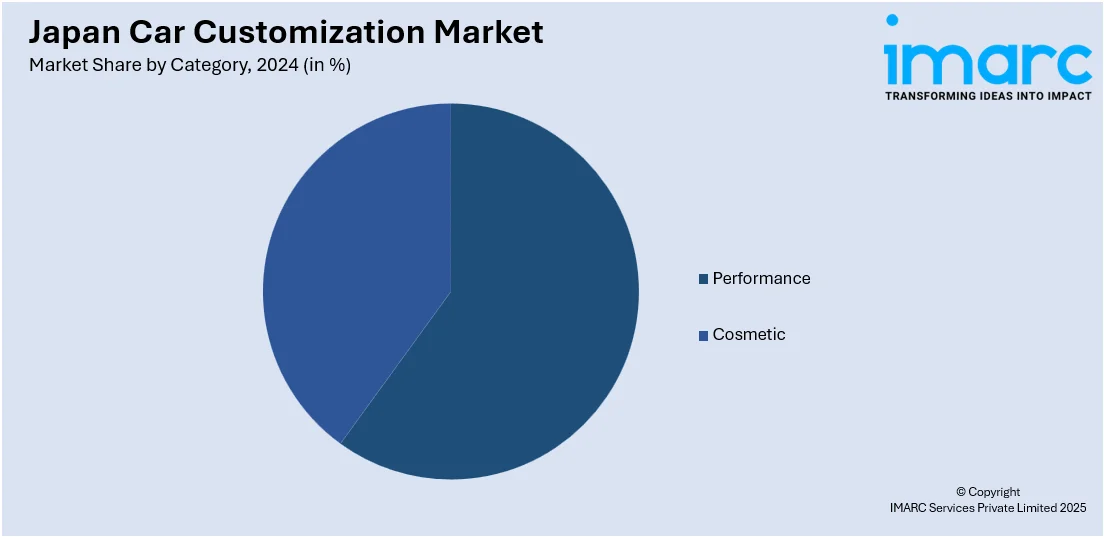
Japan Car Customization Market Size, Share, Trends and Forecast by Type, Category, Vehicle, and Region, 2025-2033
Japan Car Customization Market Overview:
The Japan car customization market size reached USD 3,479.86 Million in 2024. Looking forward, IMARC Group expects the market to reach USD 5,375.31 Million by 2033, exhibiting a growth rate (CAGR) of 4.95% during 2025-2033. The market is experiencing steady growth due to the country's long history of automobile culture, improvements in engine tuning technology and electric vehicle customization also drive this trend, allowing enthusiasts to have total control over vehicle performance. Rising disposable income, allowing consumers to invest in quality aftermarket components, also increases the Japan car customization market share.
|
Report Attribute
|
Key Statistics
|
|---|---|
|
Base Year
|
2024 |
|
Forecast Years
|
2025-2033
|
|
Historical Years
|
2019-2024
|
| Market Size in 2024 | USD 3,479.86 Million |
| Market Forecast in 2033 | USD 5,375.31 Million |
| Market Growth Rate 2025-2033 | 4.95% |
Japan Car Customization Market Trends:
Cultural Influences and Special Styles
Japan's automobile customization culture is strong in cultural expression, with fans adopting personal styles that express identity. One of the most noticeable trends is Itasha, where cars are covered with colorful decals and wraps of characters from anime, manga, or video games. This culture, which started back in the 1980s, has grown to become a big part of Japanese car culture. Fans tend to feature their customized vehicles at such events as the Tokyo Auto Salon, which is an event that celebrates the blend of pop culture and car design. In March 2026, the Odaiba Itasha Heaven event will feature approximately 1000 Itasha cars decorated with vibrant, frequently anime-themed, artwork and stickers. In addition to cars, there will also be adorned motorcycles and bicycles.

Technological Integration and Innovation
Technological advancements have had a notable impact on Japan's automobile customization industry. The launch of LED ambient lighting revolutionized the interior of cars, enabling owners to have their own unique atmospheres through programmable colors and designs. Meanwhile, utilization of carbon fiber accents and custom wheel designs has become common, reinforcing both the appearance and performance of cars. These technological advances are in response to an increasing trend for high-tech, visually appealing modifications in line with modern automotive aesthetics.
Luxury and Performance Upgrades
In Japan, luxury vehicle customization has created the VIP style, which is defined by lowered suspensions, wide-body kits, and aggressive wheel designs. Initially found on luxury sedans, the style has now been applied to other types of vehicles. Enthusiasts tend to include modifications that not only improve the look but also the performance of their vehicles, indicating a need for exclusivity and uniqueness. This trend reflects Japan's admiration for craftsmanship and attention to detail in car design, which further propels the Japan car customization market growth.
Japan Car Customization Market Segmentation:
IMARC Group provides an analysis of the key trends in each segment of the market, along with forecasts at the country and regional levels for 2025-2033. Our report has categorized the market based on type, category, and vehicle.
Type Insights:
- Overall Modification
- Local Modification
The report has provided a detailed breakup and analysis of the market based on the type. This includes overall modification and local modification.
Category Insights:

- Performance
- Cosmetic
A detailed breakup and analysis of the market based on the category has also been provided in the report. This includes performance and cosmetic.
Vehicle Insights:
- Sports Cars
- Sedans
- Sports Utility Vehicle (SUVs)
- Trucks
- Motorcycles
The report has provided a detailed breakup and analysis of the market based on the vehicle. This includes sports cars, sedans, sports utility vehicles (SUVs), trucks, and motorcycles.
Regional Insights:
- Kanto Region
- Kansai/Kinki Region
- Central /Chubu Region
- Kyushu-Okinawa Region
- Tohoku Region
- Chugoku Region
- Hokkaido Region
- Shikoku Region
The report has also provided a comprehensive analysis of all the major regional markets, which include Kanto Region, Kansai/Kinki Region, Central /Chubu Region, Kyushu-Okinawa Region, Tohoku Region, Chugoku Region, Hokkaido Region, and Shikoku Region.
Competitive Landscape:
The market research report has also provided a comprehensive analysis of the competitive landscape. Competitive analysis such as market structure, key player positioning, top winning strategies, competitive dashboard, and company evaluation quadrant has been covered in the report. Also, detailed profiles of all major companies have been provided.
Japan Car Customization Market Report Coverage:
| Report Features | Details |
|---|---|
| Base Year of the Analysis | 2024 |
| Historical Period | 2019-2024 |
| Forecast Period | 2025-2033 |
| Units | Million USD |
| Scope of the Report |
Exploration of Historical Trends and Market Outlook, Industry Catalysts and Challenges, Segment-Wise Historical and Future Market Assessment:
|
| Types Covered | Overall Modification, Local Modification |
| Categories Covered | Performance, Cosmetic |
| Vehicles Covered | Sports Cars, Sedans, Sports Utility Vehicles (SUVs), Trucks, Motorcycles |
| Regions Covered | Kanto Region, Kansai/Kinki Region, Central /Chubu Region, Kyushu-Okinawa Region, Tohoku Region, Chugoku Region, Hokkaido Region, Shikoku Region |
| Customization Scope | 10% Free Customization |
| Post-Sale Analyst Support | 10-12 Weeks |
| Delivery Format | PDF and Excel through Email (We can also provide the editable version of the report in PPT/Word format on special request) |
Key Questions Answered in This Report:
- How has the Japan car customization market performed so far and how will it perform in the coming years?
- What is the breakup of the Japan car customization market on the basis of type?
- What is the breakup of the Japan car customization market on the basis of category?
- What is the breakup of the Japan car customization market on the basis of vehicle?
- What is the breakup of the Japan car customization market on the basis of region?
- What are the various stages in the value chain of the Japan car customization market?
- What are the key driving factors and challenges in the Japan car customization market?
- What is the structure of the Japan car customization market and who are the key players?
- What is the degree of competition in the Japan car customization market?
Key Benefits for Stakeholders:
- IMARC’s industry report offers a comprehensive quantitative analysis of various market segments, historical and current market trends, market forecasts, and dynamics of the Japan car customization market from 2019-2033.
- The research report provides the latest information on the market drivers, challenges, and opportunities in the Japan car customization market.
- Porter's five forces analysis assist stakeholders in assessing the impact of new entrants, competitive rivalry, supplier power, buyer power, and the threat of substitution. It helps stakeholders to analyze the level of competition within the Japan car customization industry and its attractiveness.
- Competitive landscape allows stakeholders to understand their competitive environment and provides an insight into the current positions of key players in the market.
Need more help?
- Speak to our experienced analysts for insights on the current market scenarios.
- Include additional segments and countries to customize the report as per your requirement.
- Gain an unparalleled competitive advantage in your domain by understanding how to utilize the report and positively impacting your operations and revenue.
- For further assistance, please connect with our analysts.
 Request Customization
Request Customization
 Speak to an Analyst
Speak to an Analyst
 Request Brochure
Request Brochure
 Inquire Before Buying
Inquire Before Buying




.webp)




.webp)












